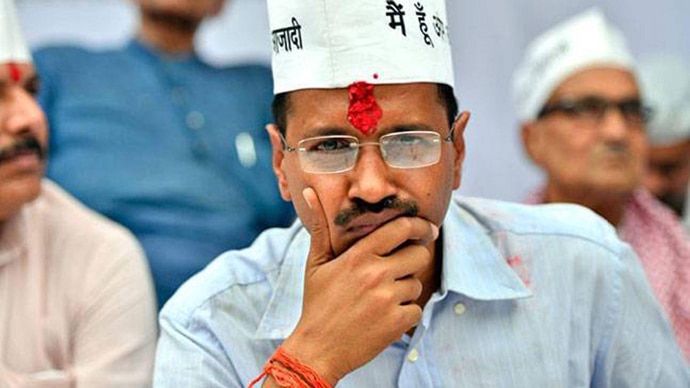Governance for anarchists: The AAP story

In the midst of all the talk about Gotra (that of Rahul Gandhi) and Ram Mandir (apparently, the ultimate goal of the BJP), the Aam Aadmi Party (AAP) has become six years old on November 26.
If we look long and hard at the political parties that invade the sensibilities of those who happen to be residents of the national capital, we cannot but note that the national parties currently seem obsessed with caste, religion and identity.
Equally, in the face of continued obstacles the “anarchists” who run the Delhi government remain obsessed with plodding on, with various schemes in education, health and currently an innovative scheme launched in September this year that delivers government services to one’s doorstep – in principle, 40 public services, including getting marriage licences, ration entitlements and so on can be handled from the doorstep.
With the bureaucracy remaining uncooperative, it’s difficult to estimate how the overall deliveries have been, but there are certainly some great blueprints for government schools, health clinics and giving people the documentation that brings benefits.
Equally, the party is broke, many of its members have abandoned ship and the troubles with the babus, the LG in Delhi and the Modi regime continue.

Yet, AAP still retains bastions in the poorer parts of Delhi, even as it remains the rare Indian party that seems to believe that delivering services to a certain section of society holds the key to political power.
The party does not draw from appealing to the traditional equations of caste, social group, community, region or language. If there is a meta-narrative they believe in, it would be rich vs poor, with their primary effort among the urban poor.
AAP actually seems to believe that they would retain power by getting the dispossessed into schools, some of which have been transformed into model schools; creating accessible health clinics and other public services. That’s quite charming and refreshing in an age when issues that should be peripheral in an overwhelmingly poor country seem to dominate the discourse.
If AAP remains an influential factor in Delhi politics after the assembly elections take place in little over a year, they would have continued their own tradition of being trail-blazers.
Yes, soon after the national elections are over in the summer of 2019, there will be only half a year left for AAP to complete its first term in government. By February 2020, it will be five years to the day that AAP won 67 of the 70 seats in Delhi’s assembly – a verdict that has arithmetically only been matched in the tiny hill state of Sikkim, in entirely different circumstances.
No “wave elections” of the past won by the Congress, the BJP or regional parties had seen such finality in the verdict. It was the grandest of sweeps.
Since then, AAP has been beset by troubles. Yet, if there is a legacy they have created in this short period, it would be that of experimenting with deliverables in governance. It’s important to remember that these emerge from the background of Chief Minister Arvind Kejriwal himself, with friend Manish Sisodia always by his side, now Deputy CM of Delhi.
Let’s flashback to 2001 after the Right to Information (RTI) Act was enacted in Delhi, courtesy the Congress regime. Kejriwal’s NGO Parivartan reportedly used it to analyse how money allocated to various schemes was being squandered. LINK

They conducted audits of public departments and managed to help a few people get what was due to them. They also held protests outside the electricity departments and when, in 2006, Kejriwal got the Ramon Magsaysay Award for emergent leadership, the citation noted that Parivartan had settled 2,500 grievances with the electricity department on behalf of individuals.
It was also during those days that Kejriwal accessed documents that revealed a proposed tie-up with the World Bank would raise the price of water in Delhi.
The point is that Kejriwal, the income tax official-turned activist-turned politician, has evolved very clear ideas about how the system works and how he would like it to change. Some of his government’s initiatives about lowering electricity tariffs, taking on the power companies, providing free water, Mohalla clinics, the attempt to curb the power of private schools, and build a public alternative, comes from that background.
The way AAP does things is to try and turf out entrenched interests who then hurt and try to hit back. One cannot but note their gumption to take on India’s most powerful business groups.
AAP remains the most successful instance of activists breaking into the political realm.
So far, most of its successes can be attributed to a group of leaders and volunteers fiercely loyal to Kejriwal who execute the political plans. The manner in which AAP won Delhi in 2015 is a blueprint for activists and citizens who wish to enter politics.

They did so, based on the findings by volunteers who believed they were working towards an alternative form of politics. That structure was built seat by seat, finding local people to raise funds, manage booths and run door-to-door campaigns.
2020 will bring different challenges. Can AAP manage a holding operation in bases in which they would have to raise volunteers? The other imponderable is its relationship with the Congress, the party that AAP truly demolished in Delhi. Both parties now see BJP as the bigger threat. The Lok Sabha election will have a spillover impact on all state contests that will follow subsequently; therefore, the stage on which AAP will fight the battle in 2020 is yet to take shape.
The only thing that can be said for sure is that it will be explosive, colourful, entertaining.
Particularly if it’s Modi vs Kejriwal in 2020.

